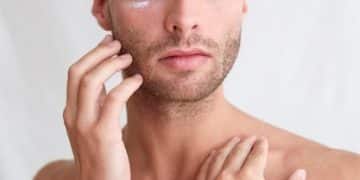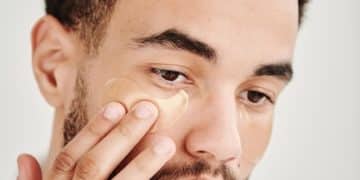How to Cover Acne: Makeup for Men – Practical Guide
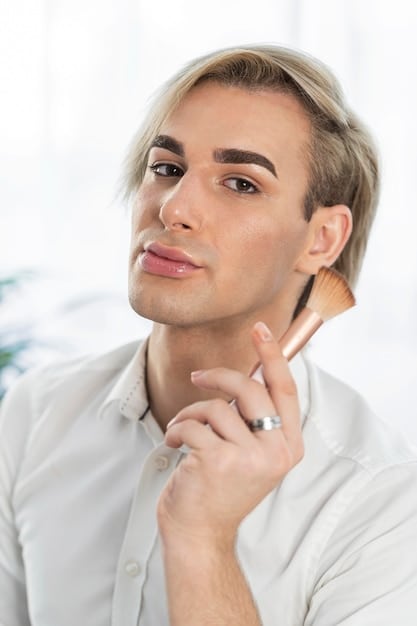
Covering acne and blemishes with makeup is a practical solution for men seeking a confident appearance by using the right products and techniques for a natural look.
How to Cover Acne and Blemishes with Makeup: A Practical Solution for Men isn’t just about aesthetics; it’s about reclaiming confidence. For many men, acne and blemishes can be a source of anxiety. Makeup offers a quick, effective way to achieve a clearer complexion. Let’s explore how to do it right.
Understanding Men’s Makeup for Acne Coverage
Makeup isn’t just for women anymore. Men are increasingly turning to makeup to address imperfections, including acne. Understanding the products and techniques that work best for men’s skin is essential. It’s about enhancing your natural features, not masking them completely.
Why Men Are Choosing Makeup
Traditional stereotypes are fading, and men are embracing self-care routines that include skincare and makeup. Here’s why:
- Confidence Boost: Covering blemishes can significantly improve self-esteem.
- Professional Appearance: Makeup can help maintain a polished look in professional settings.
- Special Occasions: Events like interviews, dates, or photoshoots call for a flawless complexion.
Key Differences in Men’s Skin
Men’s skin differs from women’s in several ways, impacting how makeup should be applied:
- Thicker Skin: Men have significantly thicker skin, affecting product absorption.
- Larger Pores: Men tend to have larger pores, making them more prone to blackheads and oiliness.
- Facial Hair: Makeup application needs to work around facial hair, requiring specific techniques.
Choosing the correct products and techniques tailored to these differences is critical. For example, a lightweight, non-comedogenic foundation is ideal for avoiding clogged pores.
Understanding these differences is the first step in achieving a natural, undetectable makeup look that enhances rather than conceals your natural features. Properly addressing these factors ensures the makeup not only looks better but also cares for your skin.
Essential Makeup Products for Acne Coverage
To effectively cover acne and blemishes, you’ll need a few key products. Each serves a specific purpose, working together to create a smooth, natural finish. Let’s explore the must-have items in your makeup kit.
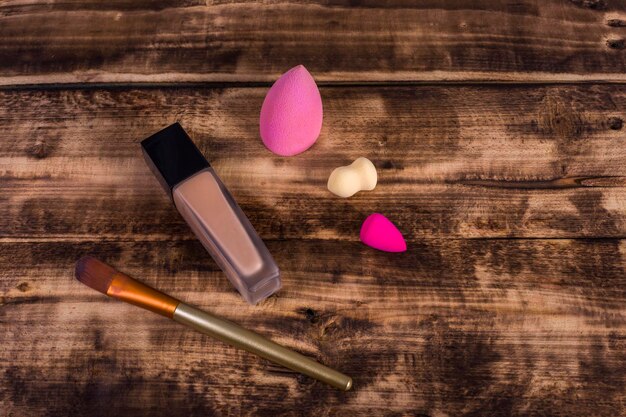
Primer: The Foundation for Success
Primer is the unsung hero of makeup, creating a smooth base and helping your makeup last longer. Here are some benefits:
- Smoothing Texture: Fills in pores and fine lines.
- Oil Control: Keeps shine at bay throughout the day.
- Prolonged Wear: Prevents makeup from fading or creasing.
Concealer: Your Spot Treatment
Concealer is designed to target specific imperfections. Choosing the right one is crucial:
- Color Correction: Green-tinted concealers can neutralize redness from acne.
- Coverage: Opt for a full-coverage concealer for significant blemishes.
- Consistency: Cream concealers work well for dry skin, while stick concealers are better for oily skin.
Foundation: Evening Out Your Skin Tone
Foundation provides an even canvas for your concealer to blend seamlessly:
- Coverage Level: A light to medium coverage foundation is often best for a natural look.
- Finish: Matte finishes are ideal for oily skin, while dewy finishes suit drier skin.
- Type: Liquid foundations are versatile, while powder foundations offer a lighter feel.
Selecting the right products tailored to your skin type and specific concerns is the foundation for achieving a natural, undetectable makeup finish. Be sure to test products to ensure they match your skin tone and address your individual needs.
These essential makeup staples will help you minimize the appearance of acne, creating a more polished and confident version of yourself. The key is to select high-quality products that complement your skin and work together harmoniously.
Step-by-Step Guide to Covering Acne
Mastering the art of covering acne requires a strategic approach. Begin by prepping your skin to ensure a smooth canvas. Follow these steps for a flawless finish that enhances your natural features.
Step 1: Skincare Prep
Start with a clean, moisturized face. Proper skincare is the foundation for makeup success:
- Cleanse: Use a gentle cleanser to remove dirt and oil.
- Moisturize: Hydrate your skin with a lightweight, non-comedogenic moisturizer.
- Prime: Apply a thin layer of primer to create a smooth base.
Step 2: Color Correcting
If you have redness, a color-correcting concealer is your best friend:
- Apply: Use a green-tinted concealer on red areas.
- Blend: Gently pat the concealer into the skin with your fingertip or a small brush.
- Less is More: Apply a thin layer to avoid a cakey look.
Step 3: Concealing Acne
Conceal individual blemishes with precision:
- Dab: Use a small concealer brush to dab concealer directly onto each blemish.
- Blend: Gently blend the edges into the surrounding skin.
- Set: Lightly dust with a translucent powder to prevent creasing.
Step 4: Applying Foundation
Even out your skin tone with foundation:
- Apply: Use a makeup sponge or brush to apply a thin layer of foundation.
- Blend: Start in the center of your face and blend outwards.
- Build: If needed, add a second thin layer to areas that need more coverage.
Step 5: Setting and Finishing
Lock in your makeup for long-lasting wear:
- Powder: Lightly dust with a translucent powder to set the makeup.
- Blot: Use blotting papers throughout the day to control shine.
- Misting Spray: Finish with a hydrating mist to blend everything together.
By following these steps, you’ll achieve a smooth, even complexion that minimizes the appearance of acne. Patience and practice are key, and with time, you’ll master the art of concealing blemishes with confidence.
The finishing touches, such as a setting spray, help not only to blend everything together seamlessly but also to enhance the longevity of the makeup, ensuring that the covered acne remains hidden throughout the day.
Choosing the Right Makeup Tools
Quality makeup tools can make a significant difference in the ease and effectiveness of your makeup application. Investing in the right brushes and sponges will pay off with a smoother, more professional finish. Let’s explore the essential tools for covering acne.
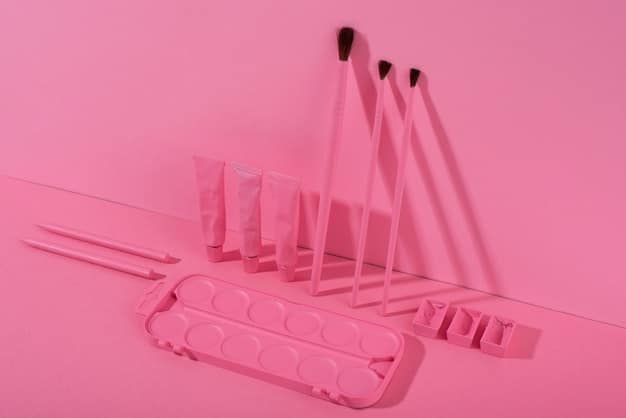
Concealer Brush: Precision Application
A good concealer brush ensures targeted coverage. Look for these features:
- Small Size: Allows for precise application on individual blemishes.
- Firm Bristles: Provides control and prevents product waste.
- Synthetic Fibers: Easy to clean and suitable for cream and liquid products.
Makeup Sponge: Seamless Blending
Makeup sponges are ideal for blending foundation and concealer:
- Dampen: Always use a damp sponge for a smoother finish.
- Bouncing Motion: Use a bouncing motion to press the product into the skin.
- Versatility: Suitable for applying foundation, concealer, and even powder.
Powder Brush: Setting the Look
A large, fluffy powder brush is essential for setting your makeup:
- Soft Bristles: Distributes powder evenly without disturbing the makeup underneath.
- Large Size: Covers a wide area quickly.
- Tapered Shape: Allows for precise application in hard-to-reach areas.
Choosing the right makeup tools tailored to your application style and the type of makeup you use can significantly improve your results. Ensure your tools are well-maintained and clean to prevent bacteria buildup and maintain their performance.
Remember that the best tools are those that feel comfortable in your hand and deliver the results you’re looking for. Investing in high-quality brushes and sponges is not just a luxury; it’s a key component of achieving a flawless makeup look, especially when covering acne.
Tips for a Natural and Undetectable Look
The goal isn’t to look like you’re wearing makeup, but rather to enhance your natural features. Achieving a natural, undetectable makeup look requires finesse and attention to detail. Follow these tips to master the art of subtle enhancement.
Less is More
Avoid applying too much product. Build coverage gradually:
- Light Layers: Apply thin layers of product, building up coverage as needed.
- Avoid Caking: Too much product can settle into fine lines and pores.
- Blend Thoroughly: Ensure all products are well-blended into the skin.
Match Your Skin Tone
Choosing the right shades is crucial for a natural look:
- Test in Natural Light: Test products in natural light to ensure a perfect match.
- Consider Undertones: Understand whether you have warm, cool, or neutral undertones.
- Adjust Seasonally: Your skin tone may change with the seasons, so adjust your shades accordingly.
Focus on Skincare
Healthy skin is the best base for makeup:
- Hydrate: Drink plenty of water and use a hydrating moisturizer.
- Exfoliate: Gently exfoliate to remove dead skin cells.
- Treat Acne: Use targeted acne treatments to improve your skin over time.
Achieving a natural, undetectable makeup look is about enhancing your natural features rather than masking them. By focusing on skincare, using the right products in moderation, and perfecting your blending technique, you can confidently cover acne without anyone knowing you’re wearing makeup.
Remember, makeup is a tool to enhance your self-confidence, and when done right, it should be almost invisible. Embrace subtlety and focus on creating a polished and natural version of yourself.
Maintaining Skin Health While Using Makeup
While makeup can provide a temporary solution for covering acne, it’s crucial to prioritize your skin’s health. Proper skincare practices are essential to prevent further breakouts and maintain a healthy complexion. Let’s explore the best practices for maintaining skin health while using makeup.
Non-Comedogenic Products
Choose makeup that won’t clog pores:
- Look for Labels: Select products labeled as “non-comedogenic” or “oil-free.”
- Read Ingredients: Avoid products with pore-clogging ingredients like mineral oil and lanolin.
- Consult Reviews: Check online reviews to see if others with acne-prone skin have had success with a product.
Proper Cleansing
Remove makeup thoroughly every night:
- Double Cleanse: Start with an oil-based cleanser to remove makeup, followed by a gentle cleanser to clean your skin.
- Use Makeup Wipes: Keep makeup wipes on hand for quick removal when you’re short on time.
- Avoid Harsh Soaps: These can strip your skin of its natural oils, leading to dryness and irritation.
Regular Exfoliation
Exfoliate to prevent clogged pores and breakouts:
- Gentle Exfoliants: Use chemical exfoliants like salicylic acid or glycolic acid.
- Avoid Harsh Scrubs: These can irritate acne and cause inflammation.
- Frequency: Exfoliate 1-2 times per week.
Maintaining your skin’s health while using makeup to cover acne is a balance between covering imperfections and caring for your skin. By choosing the right products, prioritizing proper cleansing, and incorporating regular exfoliation, you can ensure your skin remains healthy and radiant.
The routine should not only focus on removing makeup effectively but also on nourishing and protecting your skin from the potential adverse effects of daily makeup use. With a dedicated skincare routine, you can confidently use makeup to enhance your appearance while keeping your skin healthy and clear.
| Key Point | Brief Description |
|---|---|
| 🛡️ Use Primer | Creates a smooth base and prolongs makeup wear. |
| 🟢 Color Correct | Neutralize redness from acne with green-tinted concealer. |
| 🧴 Non-Comedogenic | Choose products that won’t clog pores. |
| 💧 Hydrate Daily | Keep skin moisturized to prevent dryness. |
Frequently Asked Questions
▼
Select a shade that matches your skin tone or is one shade lighter to brighten the area. Test the color on your jawline in natural light to ensure a seamless match.
▼
Use a lightweight formula, apply a thin layer, and set with a translucent powder. Avoid applying too much product, which can settle into fine lines and accentuate them.
▼
Yes, if you use comedogenic products or fail to remove makeup properly. Always choose non-comedogenic options and thoroughly cleanse your skin to prevent clogged pores.
▼
Clean your brushes at least once a week to remove bacteria and product buildup. Use a gentle brush cleanser and allow them to air dry completely.
▼
Look for products containing salicylic acid, benzoyl peroxide, or tea tree oil. These ingredients help combat acne while you wear makeup, promoting clearer skin.
Conclusion
Mastering how to cover acne and blemishes with makeup empowers men to feel more confident and presentable. By choosing the right products, practicing proper techniques, and prioritizing skincare, men can achieve a natural, undetectable look that enhances their appearance and boosts self-esteem. Remember, makeup is a tool for self-improvement, and when used correctly, it can bring about positive changes in how you perceive yourself and how others perceive you.
